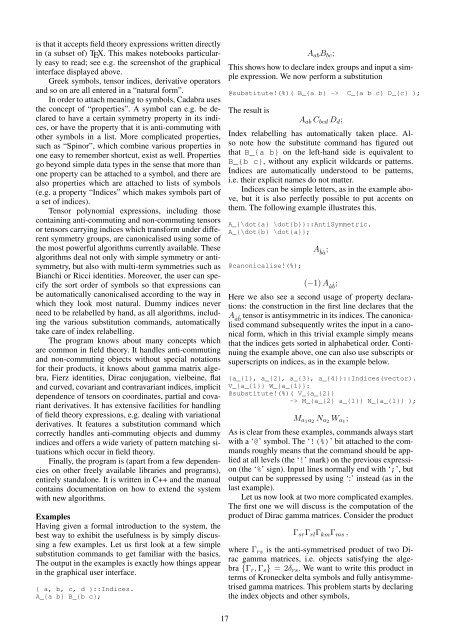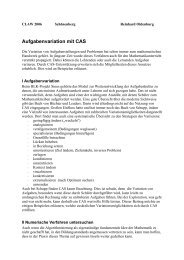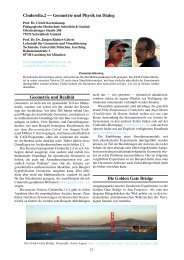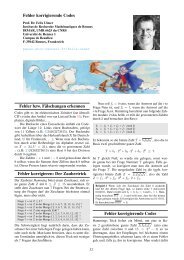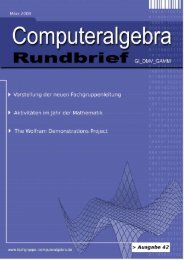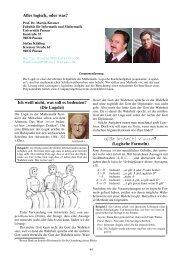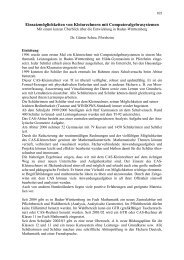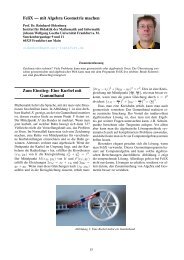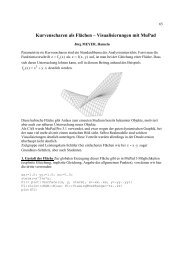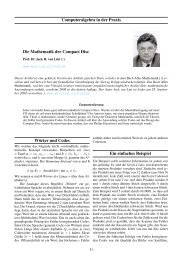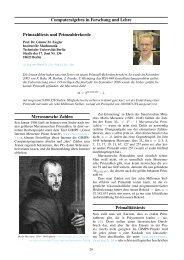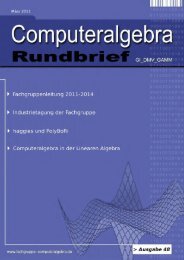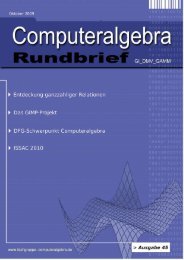mathemas | ordinate - Fachgruppe Computeralgebra
mathemas | ordinate - Fachgruppe Computeralgebra
mathemas | ordinate - Fachgruppe Computeralgebra
Erfolgreiche ePaper selbst erstellen
Machen Sie aus Ihren PDF Publikationen ein blätterbares Flipbook mit unserer einzigartigen Google optimierten e-Paper Software.
is that it accepts field theory expressions written directly<br />
in (a subset of) TEX. This makes notebooks particularly<br />
easy to read; see e.g. the screenshot of the graphical<br />
interface displayed above.<br />
Greek symbols, tensor indices, derivative operators<br />
and so on are all entered in a “natural form”.<br />
In order to attach meaning to symbols, Cadabra uses<br />
the concept of “properties”. A symbol can e.g. be declared<br />
to have a certain symmetry property in its indices,<br />
or have the property that it is anti-commuting with<br />
other symbols in a list. More complicated properties,<br />
such as “Spinor”, which combine various properties in<br />
one easy to remember shortcut, exist as well. Properties<br />
go beyond simple data types in the sense that more than<br />
one property can be attached to a symbol, and there are<br />
also properties which are attached to lists of symbols<br />
(e.g. a property “Indices” which makes symbols part of<br />
a set of indices).<br />
Tensor polynomial expressions, including those<br />
containing anti-commuting and non-commuting tensors<br />
or tensors carrying indices which transform under different<br />
symmetry groups, are canonicalised using some of<br />
the most powerful algorithms currently available. These<br />
algorithms deal not only with simple symmetry or antisymmetry,<br />
but also with multi-term symmetries such as<br />
Bianchi or Ricci identities. Moreover, the user can specify<br />
the sort order of symbols so that expressions can<br />
be automatically canonicalised according to the way in<br />
which they look most natural. Dummy indices never<br />
need to be relabelled by hand, as all algorithms, including<br />
the various substitution commands, automatically<br />
take care of index relabelling.<br />
The program knows about many concepts which<br />
are common in field theory. It handles anti-commuting<br />
and non-commuting objects without special notations<br />
for their products, it knows about gamma matrix algebra,<br />
Fierz identities, Dirac conjugation, vielbeine, flat<br />
and curved, covariant and contravariant indices, implicit<br />
dependence of tensors on co<strong>ordinate</strong>s, partial and covariant<br />
derivatives. It has extensive facilities for handling<br />
of field theory expressions, e.g. dealing with variational<br />
derivatives. It features a substitution command which<br />
correctly handles anti-commuting objects and dummy<br />
indices and offers a wide variety of pattern matching situations<br />
which occur in field theory.<br />
Finally, the program is (apart from a few dependencies<br />
on other freely available libraries and programs),<br />
entirely standalone. It is written in C++ and the manual<br />
contains documentation on how to extend the system<br />
with new algorithms.<br />
Examples<br />
Having given a formal introduction to the system, the<br />
best way to exhibit the usefulness is by simply discussing<br />
a few examples. Let us first look at a few simple<br />
substitution commands to get familiar with the basics.<br />
The output in the examples is exactly how things appear<br />
in the graphical user interface.<br />
{ a, b, c, d }::Indices.<br />
A_{a b} B_{b c};<br />
17<br />
AabBbc;<br />
This shows how to declare index groups and input a simple<br />
expression. We now perform a substitution<br />
@substitute!(%)( B_{a b} -> C_{a b c} D_{c} );<br />
The result is<br />
Aab Cbcd Dd;<br />
Index relabelling has automatically taken place. Also<br />
note how the substitute command has figured out<br />
that B_{a b} on the left-hand side is equivalent to<br />
B_{b c}, without any explicit wildcards or patterns.<br />
Indices are automatically understood to be patterns,<br />
i.e. their explicit names do not matter.<br />
Indices can be simple letters, as in the example above,<br />
but it is also perfectly possible to put accents on<br />
them. The following example illustrates this.<br />
A_{\dot{a} \dot{b}}::AntiSymmetric.<br />
A_{\dot{b} \dot{a}};<br />
@canonicalise!(%);<br />
A˙ b ˙a ;<br />
(−1) A ˙a ˙ b ;<br />
Here we also see a second usage of property declarations:<br />
the construction in the first line declares that the<br />
A ˙a ˙ b tensor is antisymmetric in its indices. The canonicalised<br />
command subsequently writes the input in a canonical<br />
form, which in this trivial example simply means<br />
that the indices gets sorted in alphabetical order. Continuing<br />
the example above, one can also use subscripts or<br />
superscripts on indices, as in the example below.<br />
{a_{1}, a_{2}, a_{3}, a_{4}}::Indices(vector).<br />
V_{a_{1}} W_{a_{1}}:<br />
@substitute!(%)( V_{a_{2}}<br />
-> M_{a_{2} a_{1}} N_{a_{1}} );<br />
Ma1a2<br />
Na2<br />
Wa1 ;<br />
As is clear from these examples, commands always start<br />
with a ‘@’ symbol. The ‘!(%)’ bit attached to the commands<br />
roughly means that the command should be applied<br />
at all levels (the ‘!’ mark) on the previous expression<br />
(the ‘%’ sign). Input lines normally end with ‘;’, but<br />
output can be suppressed by using ‘:’ instead (as in the<br />
last example).<br />
Let us now look at two more complicated examples.<br />
The first one we will discuss is the computation of the<br />
product of Dirac gamma matrices. Consider the product<br />
ΓsrΓrlΓkmΓms ,<br />
where Γrs is the anti-symmetrised product of two Dirac<br />
gamma matrices, i.e. objects satisfying the algebra<br />
{Γr, Γs} = 2δrs. We want to write this product in<br />
terms of Kronecker delta symbols and fully antisymmetrised<br />
gamma matrices. This problem starts by declaring<br />
the index objects and other symbols,


